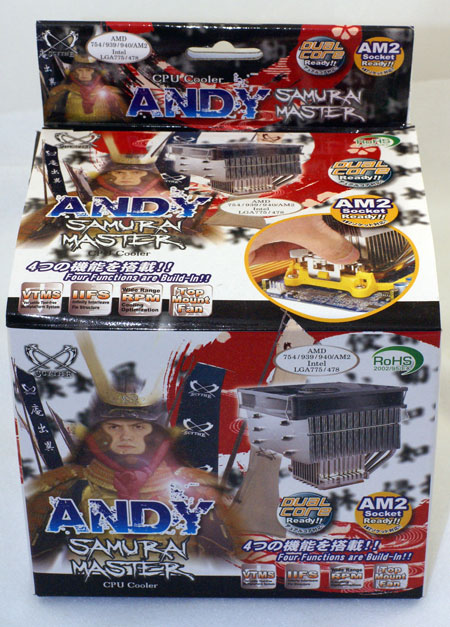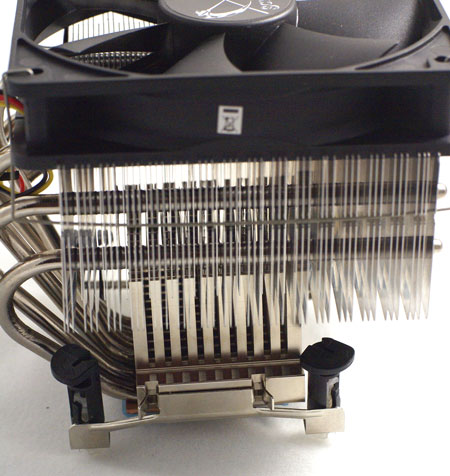Scythe Andy Samurai Master vs. Thermaltake MaxOrb
by Wesley Fink on June 4, 2007 5:00 AM EST- Posted in
- Cases/Cooling/PSUs
Scythe Andy Samurai Master
Scythe Co., Ltd. is a Japanese company located in Tokyo. Beginning in 2002 Scythe started manufacturing and distributing products for the PC enthusiast. This included CPU cooling solutions. Scythe's first product, the Scythe Samurai, developed quite a reputation among computer enthusiasts.
Scythe currently lists about a dozen air cooling solutions on their company website. These range from entry cooling solutions all the way to full cooling tower designs.
Their current catalog includes the well-known Scythe Infinity and the Scythe Ninja Rev. B full cooling tower solutions, both reviewed at AnandTech. There are also mid to low-end offerings such as the Scythe Katana that was also reviewed at AnandTech. A new top-end offering is the Andy Samurai Master.
Scythe always seems to have catchy and clever names for their coolers. They usually contain Asian warrior names, so we understand the Samurai Master. We just wonder who the "Andy" is in the Andy Samurai Master?

The box is very compact compared to the MaxOrb, and it is the typical Scythe graphics that tries to tell you everything you might ever ask about the cooler somewhere on the box. The box may be compact, but the Andy Samurai Master is a large and heavy cooler with a 120mm fan.

The Andy Samurai Master is another down-facing fan design, using an easily changed 120mm fan held on by fan wires. The heatsink uses a large aluminum fin array cantilevered over the mount to the CPU.

Six copper heatpipes extend from the copper base to the upper fin deck to provide further cooling. The best way to describe the design would be something like a large cast aluminum base heatsink with a larger heatpipe fin array attached to the top.

The Andy Samurai Master includes mounts for Intel socket 775, AMD 754/939/940/AM2, and even Intel 478. The mounting parts are cleverly designed to pop into slots on the side of the cast base.

Here we see the attached Intel 775 pop-clip sides that make the cooler ready for mounting on the Core 2 Duo test bed. The pop-clips mean you don't need to remove the motherboard to mount the Andy Samurai Master. However, things are not always as simple as they appear. The Andy overhangs the push clips on all 4 sides, and when mounted in a case we just couldn't reach all the push-clips to pop them in. We had to remove the motherboard to reach a hand in and drive that 4th clip home. The design works great on a test bench, but someone should have tried it in a real case. The overhangs make mounting without removing the motherboard almost impossible.
Specifications
Our test system is Intel socket 775, but the Scythe will mount on all current CPU sockets. All the needed hardware is included to fit the variety of supported sockets.
The Scythe is heavier and taller than the MaxOrb, but uses six heatpipes, just like MaxOrb. Scythe includes the medium output and quiet Scythe 1200rpm fan we have seen used on some other Scythe coolers, but the fan is easily switched to whatever 120mm fan you prefer.
Scythe Co., Ltd. is a Japanese company located in Tokyo. Beginning in 2002 Scythe started manufacturing and distributing products for the PC enthusiast. This included CPU cooling solutions. Scythe's first product, the Scythe Samurai, developed quite a reputation among computer enthusiasts.
Scythe currently lists about a dozen air cooling solutions on their company website. These range from entry cooling solutions all the way to full cooling tower designs.
Their current catalog includes the well-known Scythe Infinity and the Scythe Ninja Rev. B full cooling tower solutions, both reviewed at AnandTech. There are also mid to low-end offerings such as the Scythe Katana that was also reviewed at AnandTech. A new top-end offering is the Andy Samurai Master.
Scythe always seems to have catchy and clever names for their coolers. They usually contain Asian warrior names, so we understand the Samurai Master. We just wonder who the "Andy" is in the Andy Samurai Master?

The box is very compact compared to the MaxOrb, and it is the typical Scythe graphics that tries to tell you everything you might ever ask about the cooler somewhere on the box. The box may be compact, but the Andy Samurai Master is a large and heavy cooler with a 120mm fan.

The Andy Samurai Master is another down-facing fan design, using an easily changed 120mm fan held on by fan wires. The heatsink uses a large aluminum fin array cantilevered over the mount to the CPU.

Six copper heatpipes extend from the copper base to the upper fin deck to provide further cooling. The best way to describe the design would be something like a large cast aluminum base heatsink with a larger heatpipe fin array attached to the top.

The Andy Samurai Master includes mounts for Intel socket 775, AMD 754/939/940/AM2, and even Intel 478. The mounting parts are cleverly designed to pop into slots on the side of the cast base.

Here we see the attached Intel 775 pop-clip sides that make the cooler ready for mounting on the Core 2 Duo test bed. The pop-clips mean you don't need to remove the motherboard to mount the Andy Samurai Master. However, things are not always as simple as they appear. The Andy overhangs the push clips on all 4 sides, and when mounted in a case we just couldn't reach all the push-clips to pop them in. We had to remove the motherboard to reach a hand in and drive that 4th clip home. The design works great on a test bench, but someone should have tried it in a real case. The overhangs make mounting without removing the motherboard almost impossible.
Specifications
Our test system is Intel socket 775, but the Scythe will mount on all current CPU sockets. All the needed hardware is included to fit the variety of supported sockets.
| Scythe Samurai Andy Specifications | |
| Heatsink | |
| Dimensions | 125(L) X 137(D) X 104(H)mm |
| Weight | 685g (including fan) |
| Material | Pure Copper Base and Aluminum Fins |
| Heatpipes | Six 6mm copper heatpipes |
| Fan | |
| Fan Size | 120 mm x 25mm |
| Bearing Type | Sleeve Bearing |
| Connector | 3-pin |
| Speed | 1200rpm |
| Noise Level | 20.94dbA |
| Fan Output | 49.58cfm |
The Scythe is heavier and taller than the MaxOrb, but uses six heatpipes, just like MaxOrb. Scythe includes the medium output and quiet Scythe 1200rpm fan we have seen used on some other Scythe coolers, but the fan is easily switched to whatever 120mm fan you prefer.










50 Comments
View All Comments
Ver Greeneyes - Tuesday, June 5, 2007 - link
That's exactly what I said a few posts above.. I don't understand this setup. I think the best setup for a top-mounted fan would be if you've got another fan that blows air into the heatsink, which said fan then pulls away out of the case.SurJector - Monday, June 4, 2007 - link
I suspect the components on the MB do not need that much cooling. Some air, even warm, is better than none, but there is probably no need for much more.MageXX9 - Monday, June 4, 2007 - link
Does anyone else stop even considering a heatsink when I see those horrible push in clips that are the same type as the retail heat sink fan? I recently built my first Core 2 Duo system and was horrified at what a horrible design. The instructions had in big bold letters that it should only be installed when the motherboard is already in the case, but the amount of force needed to get each one to click, and the way my motherboard flexed made me vow to never use those types again.So, if I don't see a screw down design that isn't plastic I immediately write it off.
What does everyone else think?
kmmatney - Monday, June 4, 2007 - link
It's not just you. I was horrified when I built my first Socket 775 system. What a pain those plastic clips are! I'm always afraid I'm going to break something, or break something on the motherboard with the force needed to snap them into place. I've been putting off pin-modding my E4400 because I don't want to go through the hassle of removing my HSF.Imnotrichey - Monday, June 4, 2007 - link
I just dealt with those clips for the first time, 2 weeks ago on my new system. What a hassle! First, I couldn't get them all in together at once. Then finally when I do get them in, one stays out!! so I try to restart, and then I can't pull one of the pegs out, I felt like I was going to rip the mobo out before I was going to pull out the stock HSF. Luckily, I got it once I turned the case at a certain angle so I could get a good grip. Turns out one of the pegs wouldn't go down all the way. A little piece of plastic was coming up in between the peg, pushing them apart.I had to get an Arctic Cooling Pro 7, still had some issues, but eventually got it right. But definetly never want to have to fool with those screws again :)
sofarfrome - Monday, June 4, 2007 - link
...what was ambient temp during this (and other) tests? Everytime I look at the chart that compares 22 or so HSFs I see where 3 products I use always are at the top of the list (Tuniq, Scythe Ninja RevB, and now the TR Ultra 120 extreme). However, obtaining the temps Anandtech claims at 1.5875vcore is a little difficult to believe. That must be one hella cool running x6800.Wesley Fink - Monday, June 4, 2007 - link
The ambient room temperature is maintained at 20 to 22C, which is 68 to 72F. We measure ambient room temp before we begin any temperature tests. In the summer we have to turn off almpst all the equipment in the test room to keep the temperature from rising during the tests.The fans used with this 3 top coolers definitely improve the cooling with these heatpipe towers. You might want to refer back to the original reviews.
DaveLessnau - Monday, June 4, 2007 - link
If I'm reading that correctly, that means you tested without a case fan. This is definitely a problem. Without a case fan, the only way to get hot air out of the case would be because of overpressure. With nothing moving air into the case, there'd be no overpressure and thus no heat exhaust. Properly oriented side-blowing heatsink fans would provide some exhaust, but the down-blowing ones wouldn't be able to do that. Essentially, without that case fan, this test is designed to cause down-blowing heatsinks to fail.
Wesley Fink - Monday, June 4, 2007 - link
The large area behind the CPU is perforated in the test bed case so air can definitely escape due to heat rising and gravity flow. We just don't use a case fan to push the air out. It also seemed a possibility to us that we were not exhausting air as well with the down-facing fan coolers, so we also ran a few tests with the case on the side and the side (now the top) off. Cooling performance and overclocking did not improve at all.We are looking at all your suggestions to incorporate the best ideas in the new cooling test bed.
lopri - Tuesday, June 5, 2007 - link
Incredible argument. (umm.. Gravity?) Are you suggesting that we can do away with the probably single most important fan in ATX design philosophy?